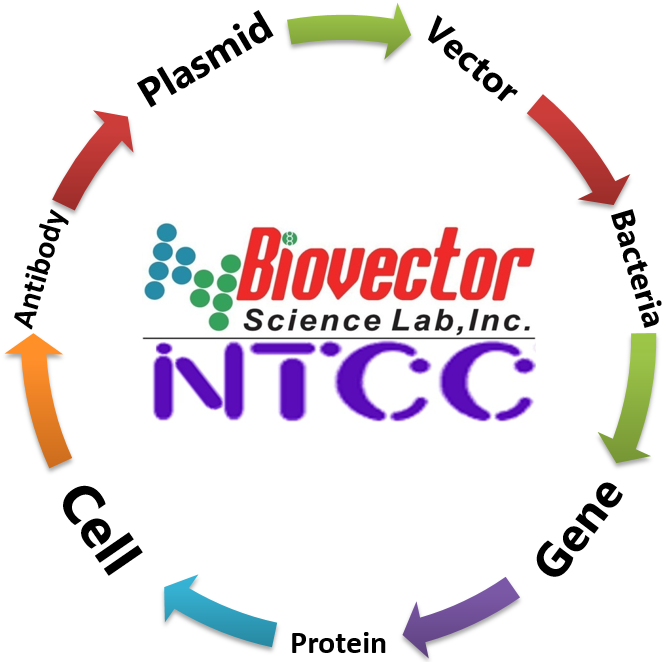- BioVector NTCC典型培養物保藏中心
- 聯系人:Dr.Xu, Biovector NTCC Inc.
電話:400-800-2947 工作QQ:1843439339 (微信同號)
郵件:Biovector@163.com
手機:18901268599
地址:北京
- 已注冊
BA/F3_ETV6-NTRK3激酶Kinase穩定表達細胞株-BioVector NTCC保藏中心
I. Introduction
Cell Line Name:
BA/F3_ETV6-NTRK3
Gene Synonyms:
ETS variant 6 ,TEL, TEL/ABL, THC5;neurotrophic receptor tyrosine kinase 3 ,GP145-TrkC, TRKC, gp145(trkC)
Host Cell:
Ba/F3
Stability: 16 passages
Application:
Anti-proliferation assay and PD assay
Freeze Medium:
90% FBS+10% DMSO
Complete Culture Medium:
RPMI-1640+10%FBS+1 ug/ml puromycin
Mycoplasma Status:
Negative
II.Background
ETV6-NTRK3 gene fusion is the translocation of genetic material between the ETV6 gene located on the short arm (designated p) of chromosome 12 at position p13.2 (i.e. 12p13.2) and the NTRK3 gene located on the long arm (designated q) of chromosome 15 at position q25.3 (i.e. 15q25.3) to create the (12;15)(p13;q25) fusion gene, ETV6-NTRK3. This new gene consists of the 5' end of ETV6 fused to the 3' end of NTRK3. ETV6-NTRK3 therefore codes for an chimeric oncoprotein consisting of the helix-loop-helix (HLH) protein dimerization domain of the ETV6 protein fused to the tyrosine kinase (i.e. PTK) domain of the NTRK3 protein. The ETV6 gene codes for the transcription factor protein, ETV6, which suppresses the expression of, and thereby regulates, various genes that in mice are required for normal hematopoiesis as well as the development and maintenance of the vascular network. NTRK3 codes for Tropomyosin receptor kinase C a NT-3 growth factor receptor cell surface protein that when bound to its growth factor ligand, neurotrophin-3, becomes an active tyrosine kinase that phosphorylates tyrosine residues on, and thereby stimulates, signaling proteins that promote the growth, survival, and proliferation of their parent cells. The tyrosine kinase of the ETV6-NTRK3 fusion protein is dysfunctional in that it is continuously active in phophorylating tyrosine residues on, and thereby continuously stimulating, proteins that promote the growth, survival, and proliferation of their parent cells. In consequence, these cells take on malignant characteristics and are on the pathway of becoming cancerous. Indeed, the ETV6-NTRK3 fusion gene appears to be a critical driver of several types of cancers. It was originally identified in congenital fibrosarcoma and subsequently found in secretory breast cancer (also termed juvenile breast cancer), Mammary analogue secretory carcinoma of salivary glands (also termed MASC or MASCSG), congenital fibrosarcoma, congenital mesoblastic nephroma, rare cases of acute myelogenous leukemia, ALK-negative Inflammatory myofibroblastic tumour, and radiation-induced papillary thyroid carcinoma.
III. Representative Data
1. Anti-proliferation assay
Figure 1. Anti-proliferation assay of two reference compounds on the BA/F3_ETV6-NTRK3 Stable Cell Line
IV. Thawing
Thawing: Protocol
1. Remove the vial from liquid nitrogen tank and thaw cells quickly in a 37°C water-bath.
2. Just before the cells are completely thawed, decontaminate the outside of the vial with 70% ethanol and transfer the cells to a 15 ml centrifuge tube containing 9 ml of complete growth medium.
3. Pellet cells by centrifugation at 200 x g force for 5 min, and discard the medium.
4. Resuspend the cells in complete growth medium.
5. Add 10 ml of the cell suspension in a 10 cm dish.
6. Add promycin to a concentration of 1 μg/ml the following day.
Kinase細胞株
現代新藥研發的關鍵首先是尋找,確定和制備藥物作用靶點。在500多個已發現的藥物靶點里中,GPCR,Ion Channel,Kinase使用的最為廣泛。
激酶(kinase)是一類從高能供體分子(如ATP)轉移磷酸基團到特定靶分子(底物)的酶;這一過程謂之磷酸化。許多腫瘤的發生是由某些與生長相關的“激酶”發生突變導致異常活化引起的,因而針對這些突變激酶的抑制劑能夠有效抑制這些激酶的活性,從而達到抑制癌細胞增長的目的。
BioVector NTCC質粒載體菌種細胞蛋白抗體基因保藏中心
電話:+86-010-53513060
網址:www.biovector.net
I. Introduction
Cell Line Name:
BA/F3_ETV6-NTRK3
Gene Synonyms:
ETS variant 6 ,TEL, TEL/ABL, THC5;neurotrophic receptor tyrosine kinase 3 ,GP145-TrkC, TRKC, gp145(trkC)
Host Cell:
Ba/F3
Stability: 16 passages
Application:
Anti-proliferation assay and PD assay
Freeze Medium:
90% FBS+10% DMSO
Complete Culture Medium:
RPMI-1640+10%FBS+1 ug/ml puromycin
Mycoplasma Status:
Negative
II.Background
ETV6-NTRK3 gene fusion is the translocation of genetic material between the ETV6 gene located on the short arm (designated p) of chromosome 12 at position p13.2 (i.e. 12p13.2) and the NTRK3 gene located on the long arm (designated q) of chromosome 15 at position q25.3 (i.e. 15q25.3) to create the (12;15)(p13;q25) fusion gene, ETV6-NTRK3. This new gene consists of the 5' end of ETV6 fused to the 3' end of NTRK3. ETV6-NTRK3 therefore codes for an chimeric oncoprotein consisting of the helix-loop-helix (HLH) protein dimerization domain of the ETV6 protein fused to the tyrosine kinase (i.e. PTK) domain of the NTRK3 protein. The ETV6 gene codes for the transcription factor protein, ETV6, which suppresses the expression of, and thereby regulates, various genes that in mice are required for normal hematopoiesis as well as the development and maintenance of the vascular network. NTRK3 codes for Tropomyosin receptor kinase C a NT-3 growth factor receptor cell surface protein that when bound to its growth factor ligand, neurotrophin-3, becomes an active tyrosine kinase that phosphorylates tyrosine residues on, and thereby stimulates, signaling proteins that promote the growth, survival, and proliferation of their parent cells. The tyrosine kinase of the ETV6-NTRK3 fusion protein is dysfunctional in that it is continuously active in phophorylating tyrosine residues on, and thereby continuously stimulating, proteins that promote the growth, survival, and proliferation of their parent cells. In consequence, these cells take on malignant characteristics and are on the pathway of becoming cancerous. Indeed, the ETV6-NTRK3 fusion gene appears to be a critical driver of several types of cancers. It was originally identified in congenital fibrosarcoma and subsequently found in secretory breast cancer (also termed juvenile breast cancer), Mammary analogue secretory carcinoma of salivary glands (also termed MASC or MASCSG), congenital fibrosarcoma, congenital mesoblastic nephroma, rare cases of acute myelogenous leukemia, ALK-negative Inflammatory myofibroblastic tumour, and radiation-induced papillary thyroid carcinoma.
III. Representative Data
1. Anti-proliferation assay
Figure 1. Anti-proliferation assay of two reference compounds on the BA/F3_ETV6-NTRK3 Stable Cell Line
IV. Thawing
Thawing: Protocol
1. Remove the vial from liquid nitrogen tank and thaw cells quickly in a 37°C water-bath.
2. Just before the cells are completely thawed, decontaminate the outside of the vial with 70% ethanol and transfer the cells to a 15 ml centrifuge tube containing 9 ml of complete growth medium.
3. Pellet cells by centrifugation at 200 x g force for 5 min, and discard the medium.
4. Resuspend the cells in complete growth medium.
5. Add 10 ml of the cell suspension in a 10 cm dish.
6. Add promycin to a concentration of 1 μg/ml the following day.
Kinase細胞株
現代新藥研發的關鍵首先是尋找,確定和制備藥物作用靶點。在500多個已發現的藥物靶點里中,GPCR,Ion Channel,Kinase使用的最為廣泛。
激酶(kinase)是一類從高能供體分子(如ATP)轉移磷酸基團到特定靶分子(底物)的酶;這一過程謂之磷酸化。許多腫瘤的發生是由某些與生長相關的“激酶”發生突變導致異常活化引起的,因而針對這些突變激酶的抑制劑能夠有效抑制這些激酶的活性,從而達到抑制癌細胞增長的目的。
BioVector NTCC質粒載體菌種細胞蛋白抗體基因保藏中心
電話:+86-010-53513060
網址:www.biovector.net
您正在向 biovector.net 發送關于產品 BA/F3_ETV6-NTRK3激酶Kinase穩定表達細胞株-BioVector NTCC保藏中心 的詢問
- 公告/新聞




